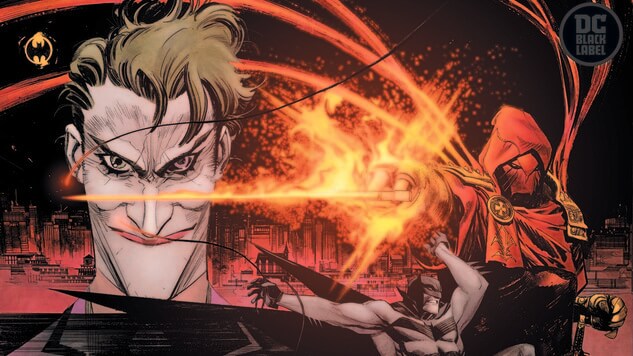Exclusive: Sean Gordon Murphy Returns to Gotham in Batman: Curse of the White Knight
The Sequel to DC Comics' Smash-Hit Batman: White Knight Arrives in 2019 & Introduces Azrael to the "Murphyverse"
Main Art by Sean Gordon Murphy & Matt Hollingsworth
Sean Gordon Murphy has a damn-impressive artistic resume, lending his unmistakable line-work to collaborations with Grant Morrison (Joe the Barbarian), Scott Snyder (The Wake), Rick Remender (Tokyo Ghost) and Mark Millar (Chrononauts). He’s perhaps the only person in the business known for executing compelling car chases, and for actually enjoying the art of drawing cars. In 2012, Murphy staked his claim as a writer/artist in the black-and-white pages of Punk Rock Jesus, and last year, he catapulted himself to the top echelon of Batman creators with the wildly popular Batman: White Knight. The eight-issue series, retroactively enveloped by DC Comics’ mature-readers Black Label imprint, imagined an alternate Gotham in which the Joker went sane—and helped expose to Gotham just how insane it is to let a grown man in a bat costume operate outside of the law. Featuring expert redesigns of Batman’s rogues gallery, intriguing new twists to familiar faces and the most sympathetic portrayal of the Joker…ever…White Knight flew off the shelves to become one of the past year’s best-selling and most popular series.
Today, Paste has the distinct pleasure of confirming what we all knew was coming: the next installment in the burgeoning “Murphyverse.” Arriving in 2019, Batman: Curse of the White Knight picks up where Batman: White Knight left off—and re-imagines a ‘90s Bat-favorite in the process. That’s right folks: Azrael is back, like you’ve never seen him before. To celebrate this announcement, and the collected edition of Batman: White Knight hitting shelves in early October, Paste exchanged a few questions with Murphy via email, covering everything from hot-button politics to a Harley identity crisis. We’ve also got the exclusive first look at Murphy’s promotional artwork for Batman: Curse of the White Knight (be sure to click through to see it in all its wallpaper-ready glory), along with DC Comics’ first official synopsis for the series. Check that out below, and stay tuned to Paste for more news on Batman: Curse of the White Knight as it’s revealed.

Batman: Curse of the White Knight Promotional Artwork by Sean Gordon Murphy
Batman: Curse of the White Knight
Writer/Artist: Sean Gordon Murphy
Release Date: 2019
In this explosive sequel to Sean Murphy’s critically acclaimed blockbuster BATMAN: WHITE KNIGHT, the Joker recruits a savage partner to help him expose a shocking revelation about the Wayne family’s legacy and run Gotham into the ground. As Batman rushes to protect the city and his loved ones from this corrupt conspiracy, the mystery of his ancestry unravels and deals a devastating blow to the Dark Knight. Exciting new villains and unexpected allies will clash across history in this unforgettable chapter of the WHITE KNIGHT saga—and the truth about the blood they shed will shake Gotham to its core!
![]()

Batman: White Knight Cover Art by Sean Gordon Murphy & Matt Hollingsworth
Paste: There’s a lot to unpack in White Knight, but before we get into any of that—what started you on the idea of a Joker rehabilitation tale? Do you remember the moment when you thought, Hey, maybe the Clown Prince of Crime could turn it all around?
Sean Gordon Murphy: I think I was 12 years old when I first started to put this story together. I remember watching Batman: The Animated Series and thinking, You know—the Joker would be a lot more threatening if he could stop acting crazy and get his shit together.
The older I got, the more I thought about that premise and the more I kept adding to it. And in the age of social media, political spin and controversy wars being waged in the court of public opinion, you can see how the rest of the story came together.
Paste: One of the biggest points of discussion around the book during its monthly run was your approach to politics within the story. You’ve given interviews where you’ve talked about wanting to represent “both sides” of issues like gun control, class conflict, vigilantism, etc. In retrospect, how do you feel about these elements of White Knight? Are you satisfied with how you pulled it off?
Murphy: My goal with White Knight was to write Gotham as a real city, not a comic book city. I wanted to turn the reader into a citizen of Gotham and pose questions about Batman that we would ask in the real world, like, Is Batman a criminal and are the police complicit? Who pays for all the collateral damage when he fights a villain? What kind of white-collar corruption would we expect to see from Gotham’s politicians and business leaders, considering they allow Batman to exist? Answering these questions can get political.
I think the trick to writing a comic that successfully talks about politics is to include diverse characters with diverse opinions, then to do your best to treat those opinions fairly and accurately in a way that would satisfy readers who might share them.
-

-

-

-

-

-

-

-

-

-

-

-

-

-

-

-

-

-

-

-

-

-

-

-

-

-

-

-

-

-

-

-

-

-

-

-

-

-

-

-











































